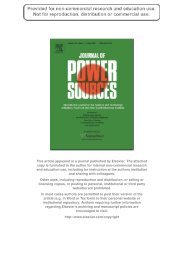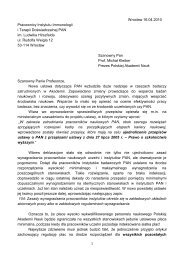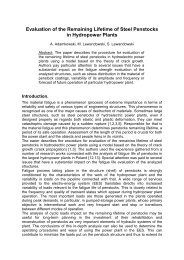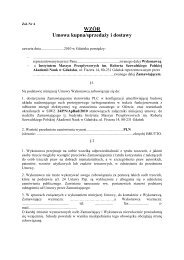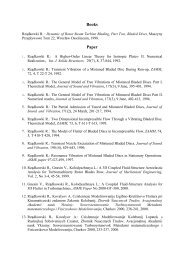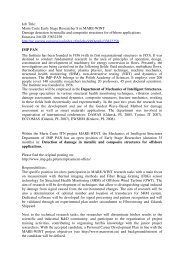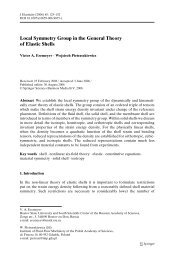Phenomenological models of cavitation erosion kinetics
Phenomenological models of cavitation erosion kinetics
Phenomenological models of cavitation erosion kinetics
- No tags were found...
Create successful ePaper yourself
Turn your PDF publications into a flip-book with our unique Google optimized e-Paper software.
4 International Cavitation Erosion Test Seminar, Sopot, 1-2 June 2000where the expression under the integral sign denotes <strong>erosion</strong> rate at the surface element uncoveredin the instant T.F.J.Heymann states that realistic <strong>erosion</strong> curves can be obtained by assuming the f(t)function to vanish in the initial period <strong>of</strong> exposure (t ≤ T 0 ), and then to be described by athree-parameter logarithmic-normal distribution[ ln( t − T ) − m]21 ⎪⎧−⎪⎫0f () t = exp⎨2 ⎬(2)σ ( t − T0 ) 2π⎪⎩ 2σ⎪⎭For the original surface layer F.J.Heymann proposes to use a distribution with parametersdifferent from those applied for the subsequent layers. However, there are no hints on themethod <strong>of</strong> their determination to be found in reference [4].Later on, J.Noskievič [5] and K.Steller [6] proposed <strong>models</strong> <strong>of</strong> <strong>erosion</strong> <strong>kinetics</strong> referringdirectly to the <strong>erosion</strong> curve pattern.J.Noskievič has noticed that the instantaneous <strong>erosion</strong> rate curve, IER =IER(t) remindsthat <strong>of</strong> damped harmonic oscillator motion. The equation <strong>of</strong> motion <strong>of</strong> such an oscillator canbe written asd2( IER) d( IER)dt22+ 2α + β IER = I . (3)dtwith α and β denoting coefficients responsible for material properties (α - work-hardeningcapability, β - <strong>cavitation</strong> resistance), and I - parameter characterising intensity <strong>of</strong> <strong>cavitation</strong>erosive activity (I = const). By assuming <strong>erosion</strong> rate and its first derivative to vanish at thebeginning <strong>of</strong> the process, the solution <strong>of</strong> equation (3) can be written down as−κtκt[( α −κ) e − ( α + κ ) e ]−αt⎧ e⎪vs+ vs⎪2κ−αt⎪vs− vs( 1+α2t)eIER()t = ⎨⎪ ⎛ α ⎞vs− vs⎜cosωt− sinωt⎟e⎪ ⎝ ω ⎠⎪⎩vs− vscosωt−αtififififα > βα = ± βα < βα = 0andα ≠ 0, (4)2 22where κ = α − β and ω = β −α2 , whence the volume loss curve is given by:∆V= vs−αt⎡ α e ⎛α+ κ kt α −κ−kt⎞⎤⎢t− 2 + ⎜ e − e ⎟⎥⎣ β 2if ⏐α⏐ > β (5a)2κ⎝α−κα + κ ⎠⎦∆ V= vs⎡ 2 ⎛ 2 ⎞⎢t− + ⎜t+ ⎟e⎣ α ⎝ α ⎠−αt⎤⎥⎦if α =±β(5b)⎧ α α t ⎡⎛⎞⎤⎫−αα ω∆V = vs⎨t− 2 2+ 2e ⎢⎜− ⎟ sin ωt+2 cosωt⎣⎝⎠⎥⎬,⎩ β β ω α⎦⎭if ⏐α ⏐< β and α ≠ 0 (5c)⎞⎜1∆V= v − s t ω t ⎟⎝ ω sin ,⎠if α = 0 (5d)



